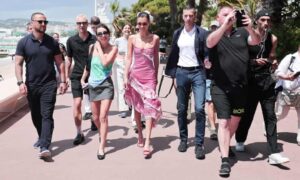
There has been very little by way of political dressing at the Cannes film festival now taking place in the south of France, but the model and wellness entrepreneur Bella Hadid bucked the trend. Walking along the seafront on Thursday, she wore a dress crafted out of red and white keffiyehs.
While earlier in the week Cate Blanchett wore a dress that some saw as a pro-Palestinian statement, others as an optical illusion, Hadid’s dress, which is apparently the work of the artist and designer Hushidar Mortezaie, left no room for doubt.
The model, whose father is Palestinian, has faced death threats for her outspoken support of the Palestinian cause.
The keffiyeh, a distinctive chequered headscarf often referred to as Palestine’s unofficial flag, has been worn at pro-Palestinian protests for decades.
Until recently, the only remaining keffiyeh factory in Palestine, Hirbawi, had been on its last legs, struggling to remain afloat amid a sea of cheap Chinese imports. In 1995, the factory in the West Bank city of Hebron was forced to shut for five years owing to a lack of demand and in 2010 it employed only one person beyond the three family members at the helm.
Now there are about 20 employees, Nael Alqassis, a spokesperson for Hirbawi, said from the business’s export office in Portugal.
The family has been making keffiyehs on the same 15 looms since the 1950s, even though they regularly break down and have to be sent to the local blacksmith for repair as parts are hard to import.
In the past few months, the factory has been reporting a huge increase in demand. In the first few weeks of the Israeli offensive in Gaza – which began after Hamas’s deadly attacks in Israel on 7 October, when the group killed 1,200 people and abducted about 240 hostages – the family-run business sold 20,000 scarves, a number it would normally sell over the entire winter. A later restock of 5,000 keffiyehs sold out within 12 hours and subsequent restocks, which are happening every two to three weeks, continue to sell out.
“For a Chinese counterfeiter this is not a lot; this is a joke. But for the original product this is really a lot,” Alqassis said.
Traditionally they made keffiyehs in black and white or red and white, but now they offer about 50 different designs, many inspired by different places within the Palestinian territories. The Gaza keffiyeh, Alqassis said, has strong pink and red colours, because “for us Palestinians when we talk about Gazans it’s these people who like to ‘eat sharp’ – they use a lot of chilli in their food”.
